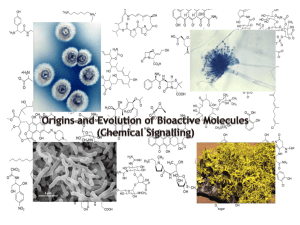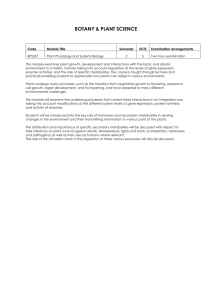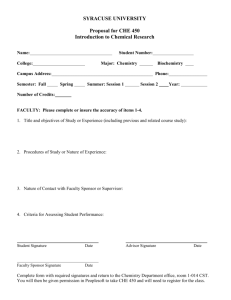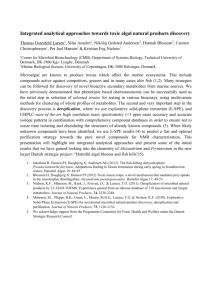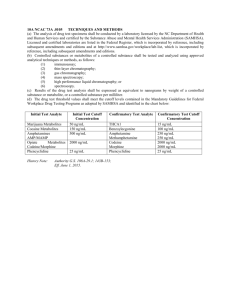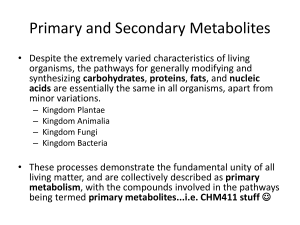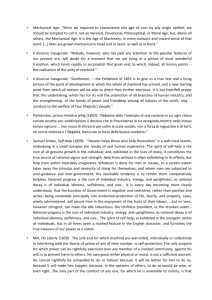CHE Yongsheng
advertisement
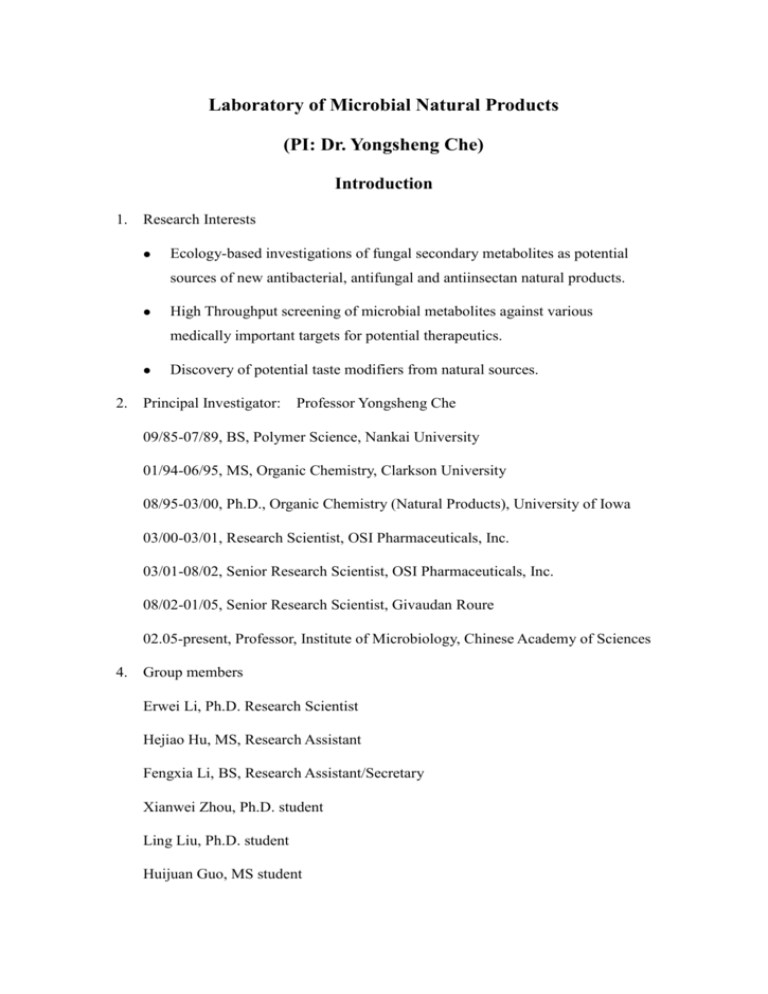
Laboratory of Microbial Natural Products (PI: Dr. Yongsheng Che) Introduction 1. Research Interests Ecology-based investigations of fungal secondary metabolites as potential sources of new antibacterial, antifungal and antiinsectan natural products. High Throughput screening of microbial metabolites against various medically important targets for potential therapeutics. Discovery of potential taste modifiers from natural sources. 2. Principal Investigator: Professor Yongsheng Che 09/85-07/89, BS, Polymer Science, Nankai University 01/94-06/95, MS, Organic Chemistry, Clarkson University 08/95-03/00, Ph.D., Organic Chemistry (Natural Products), University of Iowa 03/00-03/01, Research Scientist, OSI Pharmaceuticals, Inc. 03/01-08/02, Senior Research Scientist, OSI Pharmaceuticals, Inc. 08/02-01/05, Senior Research Scientist, Givaudan Roure 02.05-present, Professor, Institute of Microbiology, Chinese Academy of Sciences 4. Group members Erwei Li, Ph.D. Research Scientist Hejiao Hu, MS, Research Assistant Fengxia Li, BS, Research Assistant/Secretary Xianwei Zhou, Ph.D. student Ling Liu, Ph.D. student Huijuan Guo, MS student Yan Li, MS student Ji Luo, MS student Background and Significance Natural products are important sources for new medicines, and numerous bioactive natural products have been discovered from plants, microorganisms, and marine sources. According to a recent review, of the 1031 New Chemical Entities (NCEs) to reach the market as drugs covering all diseases during the period of 1981-2002, roughly 60% are either natural products, natural product-derived, natural product mimics, or biologicals (peptides or proteins) of natural origin. This is especially evident in the fields of cancer and infectious diseases, where over 60% and 75% of the drugs are of natural origin, respectively. Notable examples from fungal sources are multi-billion dollar classes of antibiotics that include penicillins and cephalosporins, the important and widely used cholesterol-lowing agents lovastatin, compactin, and pravastatin, and the immunosuppresant cyclosporin A. Ecology-based approaches have proven to be extremely valuable in the search for bioactive natural products. It is generally accepted that plants produce compounds that serve as chemical defenses against insects, herbivorous vertebrates, or microbial attack. Certain marine animals are also known to produce or accumulate antifeedant/ichthyotoxic agents that protect them from attack by predators. Similar interactions occur among fungi, and can also serve as leads to the discovery of new bioactive metabolites. For example, observed avoidance of the sclerotia of Aspergillus flavus by the ecologically relevant insect Carpophilous hemipterus led to the discovery of a variety of new antiinsectan natural products. Chemical studies of mycoparasites (fungicolous fungi that are parasitizes of other fungal species) could be viewed as a logical approach to the search for new antifungal agents. For example, fungi that attack the sclerotia of A. flavus have been found to produce new secondary metabolites with activity against A. flavus. These and other examples clearly demonstrate the utility of applying ecology-based approach in natural products research. Major Achievements Representative publications Pseudodestruxins A and B: New Cyclic Depsipeptides from the Coprophilous Fungus Nigrosabulum globosum, Y. Che, D. C. Swenson, J. B. Gloer, B. Koster, D. Malloch. J. Nat. Prod. 2001, 64, 555-558. Phomadecalins A-D and Phomapentanone A: New Bioactive Metabolites from Phoma sp. NRRL 25697, a Fungal Colonist of Hypoxylon Stromata, Y. Che, J. B. Gloer, D. T. Wicklow. J. Nat. Prod. 2002, 65, 399-402. Decipienin A and Decipienolides A-B: New Bioactive Metabolites from the Coprophilous Fungus Podopsora decipiens, Y. Che, J. B. Gloer, B. Koster, D. Malloch. J. Nat. Prod. 2002, 65, 916-919. Communiols A-D: New Mono- and Bis-Tetrahydrofuran Derivatives from the Coprophilous Fungus Podospora communis, Y. Che, J. B. Gloer, J. A. Scott, D. Malloch. Tetrahedron Lett. 2004, 45, 6891-6894. Curvicollides A-C: New Polyketide-Derived Lactones from a Sclerotium-Colonizing Isolate of Podospora curvicolla (NRRL 25778), Y. Che, J. B. Gloer, D. T. Wicklow. Org. Lett. 2004, 6, 1249-1252. Communiols E-H: New Bioactive Secondary Metabolites from the Coprophilous Fungus Podospora communis, Y. Che, J. B. Gloer, J. A. Scott, D. Malloch. J. Nat. Prod. 2005, 68, 435-438. Future Research Plan Overwhelming evidence indicates that bioactive secondary metabolites function as chemical defenses, naturally selected to bind to specific pharmacological receptors. Bioassay-guided screening of previously uninvestigated microorganisms, and those that occupy specific, chemically defended ecological niches will result in the discovery of new chemo types with unique biological properties. In the immediate future,the goal is to focus on the discovery of novel natural products from unique biological sources using cell-based and mechanism-based bioassays, with an effort toward studying the interactions of these compounds with pharmacologically important receptors. Utilizing microbial resources and High Throughput Screening platform at the Institute of Microbiology, the natural products group will conduct detailed chemical investigations on those active hits obtained from screening of microbial metabolite library against medically important targets, including infectious diseases, metabolic diseases, and cancer. Emphasis will be also placed upon discovery of novel taste modifiers from natural sources, such as selected fungi and plants by employing various techniques in the natural products research. The initial goal is to discover novel natural products with sweetness enhancing property and umami effect. The ultimate goal to is discover novel natural products that can be used for potential therapeutics and natural taste modifiers.
